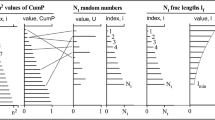Abstract
In this paper, we investigate the fractal properties of binary maps of rock fractures at different scales and different geological types, as well as different families of fracture patterns obtained from a two-dimensional Laplacian growth model (LGM). From these analyses we figure out which families of the LGM patterns match the structural properties of the fracture binary maps. The LGM is defined in terms of a nonlinear map that depends on two parameters, λ and \(\mathfrak{a}\), that respectively define the area and shape of the elements of the aggregate that conforms the patterns. The fractal dimension and roughness exponent of the LGM patterns are found to depend on \(\mathfrak{a}\), with \(0<\mathfrak {a}<1\). From a detailed statistical analysis of these patterns we found that the fractal dimensions of capacity, correlation and information decrease monotonically as \(\mathfrak{a}\) increases. We also found that the values of these three fractal dimensions tend to collapse on top of each other as \(\mathfrak{a}\lessapprox1\). Remarkably, the fractal properties of rock fractures in the scales from millimeters up to a few meters appear to be well represented by the fractal structure of the LGM families of patterns with \(\mathfrak{a}=0.15\) and 0.30, while the fractal properties of rock fractures in the scale of kilometers seems to be well represented by the LGM family with \(\mathfrak{a}=0.90\). In addition, the three fractal dimension values of fracture binary maps in the scales from millimeters up to meters were found to be different between them. Nonetheless, for fractures in the scale of kilometers, the values of the three fractal dimensions are very close to each other as an indication of self-similar behavior. Analysis of the corrections to the scaling of the roughness exponent, ζ, suggests that they are negligible for the LGM family of fracture patterns with \(\mathfrak{a}=0.9\). This finding points to a self-affine structure for this family of patterns. In fact, the calculated roughness exponent results are in the range of values characteristic of rock fractures.
Similar content being viewed by others
References
Aharony A, Fisher ME (1983) Nonlinear scaling fields and corrections to scaling near criticality. Phys Rev B 27(7):4394–4400
Balatoni J, Renyi A (1956) Publications Mathematical Institute Hungarian Academy of Sciences 1:9–40
Barber JR (1992) Elasticity, 2nd edn. Kluwer Academic, Amsterdam
Barabási AL, Vicsek T (1991) Multifractality of self-affine fractals. Phys Rev A 44:2730–2733
Barra F, Hentschel HGE, Levermann A, Procaccia I (2002a) Quasi-static fractures in brittle media and iterated conformal maps. Phys Rev E 65:045101
Barra F, Levermann A, Procaccia I (2002b) Quasi-static brittle fractures in inhomogeneous media and iterated conformal maps: Modes I, II and III. Phys Rev E 66:066122
Bouchaud E (1997) Scaling properties of cracks. J Phys Condens Matter 9:4319–4344
Blumenfeld R (1994) Formulating a first-principles statistical theory of growing surfaces in 2-dimensional Laplacian fields. Phys Rev E 50:2952–2962
Cravero M, Piana F, Ponti S, Tallone S, Balestro G, Morelli M (2006) Analysis of fracture patterns constrained by suitable geological model. American Rock Mechanics Association, Paper 06-1147
Davidovitch B, Hentschel HGE, Olami Z, Procaccia I, Sander LM, Somfai E (1999) Diffusion limited aggregation and iterated conformal maps. Phys Rev E 59(2):1368–1378
Deng J, He YF, Ye F, Long QY, Lung CW (1999) Accurate assessment of the roughness exponent of a fracture surface via scanning tunnelling microscopy. J Phys D Appl Phys 32:L45–L48
Farmer JD (1982) Chaotic attractors of an infinite-dimensional dynamical system. Physica D 4:366–393
Grasberger P, Procaccia I (1983a) Characterization of strange attractors. Phys Rev Lett 50:346–349
Grasberger P, Procaccia I (1983b) Measuring the strangeness of strange attractors. Physica D 9:189–208
Grasberger P (1988) Finite sample corrections to entropy and dimension estimates. Phys Lett A 128:369–373
Guinea F, Pla O, Louis E, Hakim V (1995) New advances in Laplacian growth models. Lecture notes in physics, vol 445. Springer, Berlin/Heidelberg
Hastings MB, Levitov LS (1998) Laplacian growth as one-dimensional turbulence. Physica D 116:244–252
Korvin G (1992) Fractals models in the earth sciences. Elsevier, Amsterdam
Krug J, Spohn H (1992) In: Godreche C (ed) Solids far from equilibrium. Cambridge Univ. Press, New York
Lam PM (1990) Correction to scaling exponent for self-avoiding walks. Phys Rev B 42(7):4447–4452
Liebovitch LS, Toth T (1989) A fast algorithm to determine fractal dimension by box counting. Phys Lett A 141:386–390
Louis E, Guinea F (1987) The fractal nature of fracture. Europhys Lett 3(8):871–877
Mandelbrot B (1985) Self-affine fractals and fractal dimension. Phys Scr 32:257–261
Mandelbrot B, Passoja DE, Paullay AJ (1984) Fractal character of fracture surfaces of metals. Nature 308:721–722
McKane A, Droz M, Vannimenus J, Wolf D (eds) (1995) Scale invariance, interfaces, and non-equilibrium dynamics. NATO science series B 344
Niemeyer L, Pietronero L, Weismann HJ (1984) Fractal dimension of dielectric breakdown. Phys. Rev. Lett. 52:1033–1036
Pietronero L, Erzan A, Evertsz C (1988) Theory of Laplacian fractals: diffusion limited aggregation and dielectric breakdown model. Physica A 151:207–245
Sarraille J (1998) http://yahi.csustan.edu/~john/jsHomepage.html
Sauer T, Yorke J (1993) Int J Bifurc Chaos 3:737
Vasilév A (2009) From the Hele–Shaw experiment to integrable systems: a historical overview. Complex Anal Oper Theory 3:551–585
Vicsek T (1992) Fractal growth phenomena. World Scientific, Singapore
Author information
Authors and Affiliations
Corresponding author
Rights and permissions
About this article
Cite this article
Aguilar-Hernández, A., Ramírez-Santiago, G. Self-Similar and Self-Affine Properties of Two-Dimensional Fracture Patterns in Rocks. Math Geosci 42, 925–954 (2010). https://doi.org/10.1007/s11004-010-9279-4
Received:
Accepted:
Published:
Issue Date:
DOI: https://doi.org/10.1007/s11004-010-9279-4




